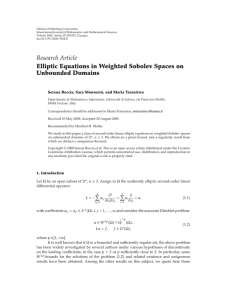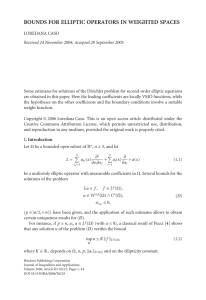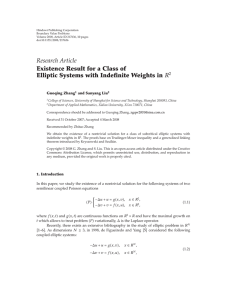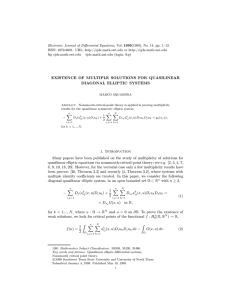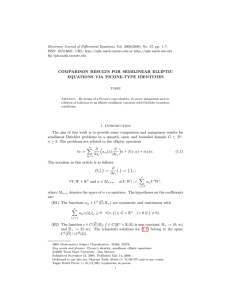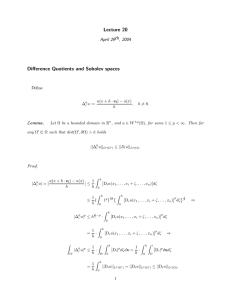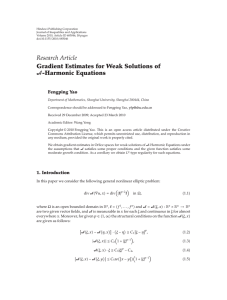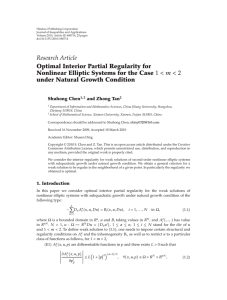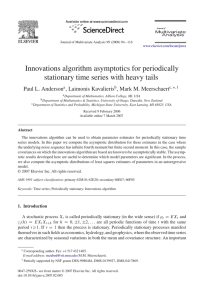Hindawi Publishing Corporation Boundary Value Problems Volume 2008, Article ID 901503, pages
advertisement
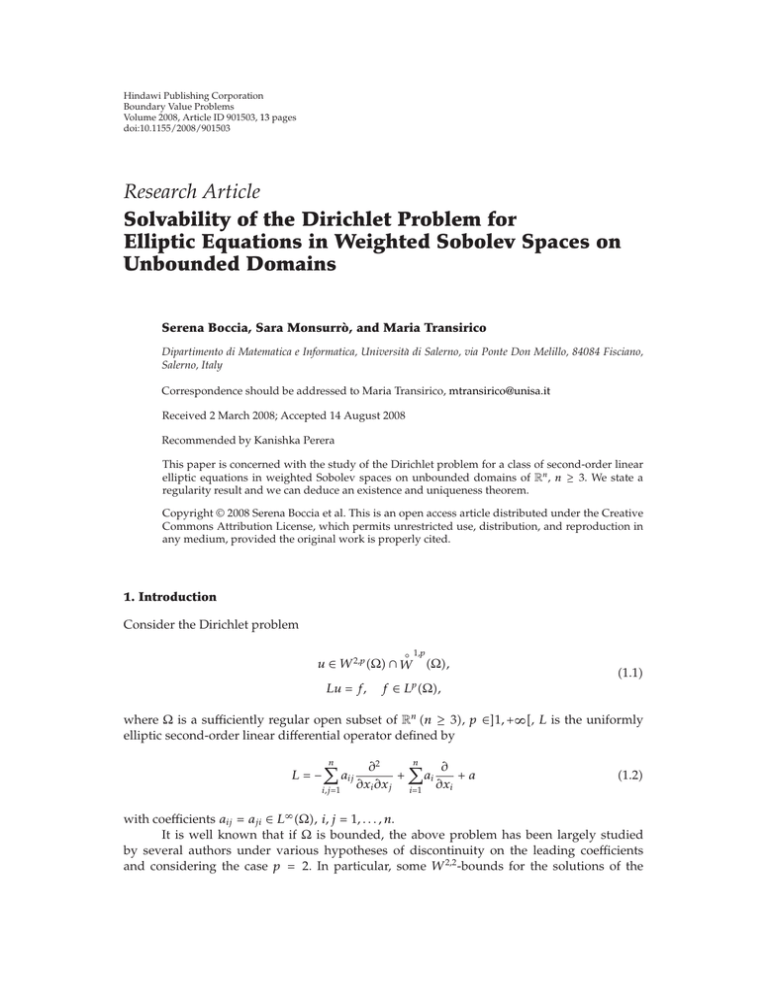
Hindawi Publishing Corporation
Boundary Value Problems
Volume 2008, Article ID 901503, 13 pages
doi:10.1155/2008/901503
Research Article
Solvability of the Dirichlet Problem for
Elliptic Equations in Weighted Sobolev Spaces on
Unbounded Domains
Serena Boccia, Sara Monsurrò, and Maria Transirico
Dipartimento di Matematica e Informatica, Università di Salerno, via Ponte Don Melillo, 84084 Fisciano,
Salerno, Italy
Correspondence should be addressed to Maria Transirico, mtransirico@unisa.it
Received 2 March 2008; Accepted 14 August 2008
Recommended by Kanishka Perera
This paper is concerned with the study of the Dirichlet problem for a class of second-order linear
elliptic equations in weighted Sobolev spaces on unbounded domains of Rn , n ≥ 3. We state a
regularity result and we can deduce an existence and uniqueness theorem.
Copyright q 2008 Serena Boccia et al. This is an open access article distributed under the Creative
Commons Attribution License, which permits unrestricted use, distribution, and reproduction in
any medium, provided the original work is properly cited.
1. Introduction
Consider the Dirichlet problem
◦ 1,p
u ∈ W 2,p Ω ∩ W
Lu f,
Ω,
f ∈ L Ω,
1.1
p
where Ω is a sufficiently regular open subset of Rn n ≥ 3, p ∈1, ∞, L is the uniformly
elliptic second-order linear differential operator defined by
L−
n
aij
i,j1
n
∂2
∂
ai
a
∂xi ∂xj i1 ∂xi
1.2
with coefficients aij aji ∈ L∞ Ω, i, j 1, . . . , n.
It is well known that if Ω is bounded, the above problem has been largely studied
by several authors under various hypotheses of discontinuity on the leading coefficients
and considering the case p 2. In particular, some W 2,2 -bounds for the solutions of the
2
Boundary Value Problems
problem 1.1 and related existence and uniqueness theorems have been obtained. Among
the other results on this subject, we quote here the classical result of 1, where the author
assumed that the aij ’s belong to W 1,n Ω. This result was later generalized in different ways,
supposing that the derivatives of the leading coefficients belong to some wider spaces. More
recently, a relevant contribution to the theory has been given in 2–5, where the coefficients
aij are assumed to be in the class VMO and p ∈1, ∞; observe here that VMO contains the
class W 1,n Ω.
If the set Ω is unbounded, under assumptions similar to those required in 1, problem
1.1 has for instance been studied in 6 with p 2, and in 7 with p ∈1, ∞. Instead, in
8, 9, the leading coefficients satisfy restrictions similar to those in 2, 3.
In 10, we extended some results of 8, 9 to a weighted case. More precisely, we
denoted by ρ a weight function belonging to a suitable class and such that
lim ρx ∞.
inf ρ > 0,
Ω
|x|→∞
1.3
Then we considered the problem
◦ 1,p
2,p
u ∈ Ws Ω ∩ W s Ω,
Lu f,
2,p
◦ 1,p
f∈
p
Ls Ω,
1.4
p
where s ∈ R, Ws Ω, W s Ω, and Ls Ω are some weighted Sobolev spaces and the weight
functions are a suitable power of ρ. We obtained that the operator L has closed range and that
for the problem 1.4 a uniqueness result holds.
In this paper, we study again the problem 1.4. We state a regularity result which
allows us to obtain the solvability of the problem.
A similar weighted case was studied in 11 with the leading coefficients satisfying
hypotheses of Miranda’s type and when p 2.
2. Weight functions and weighted spaces
Let G be any Lebesgue measurable subset of Rn and let ΣG be the collection of all Lebesgue
measurable subsets of G. Let F ∈ ΣG. Denote by |F| the Lebesgue measure of F, by χF the
characteristic function of F, and by DF the class of restrictions to F of functions ζ ∈ C◦∞ Rn with F ∩ supp ζ ⊆ F. Moreover, if XF is a space of functions defined on F, we denote by
Xloc F the class of all functions g : F → R such that ζg ∈ XF for any ζ ∈ DF. Finally,
for any x ∈ Rn and r ∈ R , we put Bx, r {y ∈ Rn : |y − x| < r}, Br B0, r, and
Fx, r F ∩ Bx, r.
Let Ω be an open subset of Rn . We introduce a class of weight functions defined on Ω.
Denote by AΩ the set of all measurable functions ρ : Ω→R such that
γ −1 ρy ≤ ρx ≤ γρy,
∀ y ∈ Ω, ∀ x ∈ Ωy, ρy,
2.1
where γ ∈ R is independent of x and y.
We note that the class of all functions ρ : Ω→R which are Lipschitz continuous in Ω
with Lipschitz coefficient < 1 is contained in AΩ see 12.
For ρ ∈ AΩ, we put
2.2
Sρ z ∈ ∂Ω : lim ρx 0 .
x→z
Serena Boccia et al.
3
It is known that
ρ ∈ L∞
loc Ω,
ρ−1 ∈ L∞
loc Ω \ Sρ ,
2.3
see 12, 13.
We assign an unbounded open subset Ω of Rn .
From now on, let ρ1 be a function such that ρ1 ∈ ARn and
lim ρ1 x ∞.
inf ρ1 > 0,
Ω
2.4
|x|→∞
For example,
ρ1 : x ∈ Rn −→ 1 a|x|,
a ∈0, 1.
2.5
We put
ρ ρ1|Ω ,
2.6
and note that ρ−1 ∈ L∞ Ω.
For any a ∈0, 1 and x ∈ Rn , we set
Ia x Ωx, aρ1 x,
Ea x {y ∈ Rn | x ∈ By, aρ1 y},
2.7
and note that
c ρ1n x ≤ |Ea x| ≤ c ρ1n x ∀ x ∈ Rn ,
2.8
where c , c ∈ R depend only on n, a, ρ see 12.
If v is a real function defined in Ω, we denote by v0 the zero extension of v in Rn .
We begin to prove the following.
Lemma 2.1. If v, g are two nonnegative functions in L1loc Ω, L1loc Rn , respectively, then for any
a ∈0, 1,
vxgL1 Ea x dx gxvL1 Ia x dx,
2.9
Ω
Rn
and for ν ∈1, ∞, the following also hold:
ν
gxvL1 Ia x dx ≤
vxg1/ν
L1 E
Rn
a
Ω
Proof. The equality 2.9 follows by
vxgL1 Ea x dx Ω
Rn
dx
Ea x
2.10
v0 xgydy
Rn
dy
By,aρ1 y
v0 xgydx
.
ν
dx
x
Rn
gxvL1 Ia x dx.
2.11
4
Boundary Value Problems
Prove now the inequality 2.10. We observe that:
gxvνL1 Ia x dx gxdx
Rn
Rn
Bx,aρ1 x
gx1/ν hxdx
Bx,aρ1 x
v0 ydy
2.12
Rn
dy
Ea y
ν
Rn
v0 ydy
gx
1/ν
hxv0 ydx
Ω
vydy
Ea y
gx1/ν hxdx,
where we have put
hx gx1−1/ν
Bx,aρ1 x
v0 ydy
ν−1
2.13
.
On the other hand,
Ea y
gx
1/ν
hxdx ≤
1/ν Ea y
gxdx
Ea y
1/ν Ea y
gxdx
Ea y
hx
ν/ν−1
ν−1/ν
dx
gxvνL1 Ia x dx
2.14
ν−1/ν
.
Therefore, from 2.12 and 2.14, we deduce that
R
gxvνL1 Ia x dx
n
≤
R
gxvνL1 Ia x dx
n
ν−1/ν Ω
vyg1/ν
L1 E
a y
2.15
dy.
By 2.15, it obviously follows
Rn
gxvνL1 Ia x dx
1/ν
≤
Ω
vxg1/ν
L1 E
a x
2.16
dx,
and 2.16 yields the inequality 2.10.
k,p
If k ∈ N0 , 1 ≤ p < ∞ and s ∈ R, consider the space Ws Ω of distributions u on Ω
such that ρs ∂α u ∈ Lp Ω for |α| ≤ k, equipped with the norm
uW k,p Ω ρs ∂α uLp Ω .
2.17
s
◦ k,p
|α|≤k
k,p
0,p
p
Moreover, denote by W s Ω the closure of C◦∞ Ω in Ws Ω and put Ws Ω Ls Ω. A
more detailed account of properties of the above-defined spaces can be found, for instance,
in 14.
From Lemma 2.1 we can deduce another lemma which we will need in the proof of
our regularity result.
Serena Boccia et al.
5
p
p
Lemma 2.2. Let p ∈ 1, ∞, s ∈ R, and a ∈0, 1. Then u ∈ Ls Ω if and only if u ∈ Lloc Ω and
the function x ∈
such that
s−n/p
xuLp Ia x
Rn → ρ1
p
c1 uLp Ω ≤
s
sp−n
Rn
ρ1
belongs to Lp Rn . In addition, there exist c1 , c2 ∈ R
p
p
xuLp Ia x dx ≤ c2 uLp Ω
s
p
∀ u ∈ Ls Ω,
2.18
p
where c1 and c2 depend only on n, p, s, a, and ρ. Moreover, if p0 ∈ 1, p and u ∈ Ls 0 Ω, then the
s−n/p
xuLp0 Ia x belongs to Lp Rn and the following estimate holds:
function x ∈ Rn → ρ1
sp−n
p
p
ρ1 xuLp0 Ia x dx ≤ c3 u p0
2.19
Ls Ω
Rn
with c3 ∈ R dependent only on n, p, p0 , s, a, and ρ.
sp−n
Proof. The first part of the lemma follows from 2.9 for g ρ1
and v |u|p , if one uses
2.1 and 2.8. The second part of the lemma follows in a similar way from the inequality
sp−n
2.10, if one puts g ρ1 , v |u|p0 , and ν p/p0 .
3. An embedding lemma
We now recall the definitions of the function spaces in which the coefficients of the operator
will be chosen. If Ω has the property
|Ωx, r| ≥ Ar n
∀ x ∈ Ω, ∀ r ∈0, 1,
3.1
where A is a positive constant independent of x and r, it is possible to consider the space
BMOΩ, τ τ ∈ R of functions g ∈ L1loc Ω such that
< ∞,
g − —
3.2
gBMOΩ,τ sup —
g
x∈Ω
r∈0,τ
where
—
Ωx,r
Ωx,r
g |Ωx, r|
Ωx,r
−1
Ωx,r
g.
If g ∈ BMOΩ BMOΩ, τA , where
⎧
⎫
⎪
⎪
⎨
n
r
1⎬
τA sup τ ∈ R : sup
≤
,
⎪
A⎪
⎩
⎭
x∈Ω |Ωx, r|
3.3
3.4
r∈0,τ
we will say that g ∈ VMOΩ if gBMOΩ,τ → 0 for τ → 0 . A function
ηg :0, 1 −→ R
3.5
is called a modulus of continuity of g in VMOΩ if
gBMOΩ,τ ≤ ηgτ ∀ τ ∈0, 1,
lim ηgτ 0.
τ→0
3.6
For t ∈ 1, ∞ and λ ∈ 0, n, we denote by Mt,λ Ω the set of all functions g in Ltloc Ω such
that
gMt,λ Ω sup r −λ/t gLt Ωx,r < ∞
r∈0,1
x∈Ω
3.7
6
Boundary Value Problems
t,λ Ω as the closure of L∞ Ω in
endowed with the norm defined by 3.7. Then we define M
t,λ
t,λ
∞
t,λ
M Ω and M◦ Ω as the closure of C◦ Ω in M Ω. In particular, we put Mt Ω t Ω M
t,0 Ω, and M◦t Ω M◦t,0 Ω. In order to define the modulus of
Mt,0 Ω, M
t,λ Ω, recall first that for a function g ∈ Mt,λ Ω the following
continuity of a function g in M
characterization holds:
t,λ Ω ⇐⇒ lim pg τ 0,
g∈M
3.8
τ→0
where
pg τ χE gMt,λ Ω ,
sup
τ ∈ R .
3.9
E∈ΣΩ
supx∈Ω |Ex,1|≤τ
t,λ Ω is a function
Thus the modulus of continuity of g ∈ M
σ g :0, 1 −→ R ,
3.10
such that
pg τ ≤ σ gτ ∀ τ ∈0, 1,
lim σ gτ 0.
τ→0
3.11
A more detailed account of properties of the above defined function spaces can be found in
6, 15, 16.
We consider the following condition:
h0 Ω has the cone property, p ∈1, ∞, s ∈ R, k, h, t are numbers such that
k ∈ N,
h ∈ {0, 1, . . . , k − 1},
t ≥ p,
t>p
if p n
,
k−h
g ∈ Mt Ω.
3.12
From 17, Theorem 3.1 we have the following.
k,p
p
Lemma 3.1. If the assumption (h0 ) holds, then for any u ∈ Ws Ω, it results that g∂h u ∈ Ls Ω
and
g∂h uLps Ω ≤ cgMt Ω uW k,p Ω
s
3.13
with c dependent only on Ω, n, k, h, p, and t.
4. A regularity result
Assume that Ω is an unbounded open subset of Rn , n ≥ 3, with the uniform C1,1 -regularity
property, and let ρ be the function defined by 2.6. Moreover, let p ∈1, ∞ and s ∈ R.
Consider in Ω the differential operator
L−
n
aij
i,j1
n
∂2
∂
ai
a,
∂xi ∂xj i1 ∂xi
with the following conditions on the coefficients:
4.1
Serena Boccia et al.
7
h1 aij aji ∈ L∞ Ω ∩ VMOloc Ω,
n
∃ν > 0 :
aij ξi ξj ≥ ν|ξ|2
i, j 1, . . . , n,
a.e. in Ω ∀ ξ ∈ Rn ,
4.2
i,j1
there exist functions eij , i, j 1, . . . , n, g and μ ∈ R such that
h2 eij eji ∈ L∞ Ω ∩ VMOΩ,
n
eij ξi ξj ≥ μ|ξ|2
i,j1
g ∈ L∞ Ω,
lim
i, j 1, . . . , n,
a.e. in Ω ∀ ξ ∈ Rn ,
n
4.3
eij − gaij L∞ Ω\Br 0,
r→∞
i,j1
h3 t1 Ω,
ai ∈ M
t2 Ω,
i 1, . . . , n, a ∈ M
4.4
where
t1 > n if p ≤ n,
t1 p
if p > n,
n
,
2
t2 p
if p >
t2 >
n
2
if p ≤
n
.
2
4.5
Observe that under the assumptions h1 –h3 , it follows that the operator L :
2,p
p
Ws Ω→Ls Ω is bounded from Lemma 3.1.
Theorem 4.1. Suppose that the assumptions (h1 ), (h2 ), and (h3 ) hold, and let u be a solution of the
problem
◦ 1,q
2,q
p
u ∈ Wloc Ω ∩ W loc Ω ∩ Ls 0 Ω,
p
Lu ∈ Ls Ω,
4.6
2,p
where q ∈1, p and p0 ∈ 1, p. Then u belongs to Ws Ω.
Proof. By 8, Lemma 4.1, we have
2,p
◦ 1,p
u ∈ Wloc Ω ∩ W loc Ω.
4.7
We choose r, r ∈ R , with r < r < 1, and a function φ ∈ C◦∞ Rn such that
φ|Br 1,
supp φ ⊂ Br ,
sup|∂α φ| ≤ cα r − r−|α|
Rn
where cα ∈ R depends only on α.
∀ α ∈ Nn0 ,
4.8
8
Boundary Value Problems
We fix y ∈ Rn and put
x−y
.
ψ ψy : x ∈ R −→ φ
ρ1 y
4.9
n
Clearly, we have
supp ψ ⊂ By, r ρ1 y,
ψ|By,rρ1 y 1,
−|α|
sup|∂α ψ| ≤ cα ρ1 yr − r−|α|
Rn
◦ 1,p
Since ψu ∈ W 2,p Ω ∩ W
4.10
∀ α ∈ Nn0 .
Ω, from 8, Theorem 3.1 it follows that
ψuW 2,p Ω ≤ c1 LψuLp Ω ψuLp Ω 4.11
with c1 depending on n, p, Ω, ν, μ, t1 , t2 , aij L∞ Ω , eij L∞ Ω , gL∞ Ω , ηζ2r0 aij , ηeij ,
σ ai , σ a, where r0 ∈ R depends on n, p, Ω, μ, eij L∞ Ω , ηeij and ζ2r0 is a function in
C◦∞ Rn such that
0 ≤ ζ2r0 ≤ 1,
ζ2r0 |B2r0 1,
supp ζ2r0 ⊂ B4r0 .
4.12
Since
Lψu −
n
aij ψuxi xj i,j1
ψLu − 2
n
i,j1
n
ai ψuxi aψu
i1
aij ψxi uxj n
4.13
n
aij ψxi xj u ai ψxi u
i,j1
i1
from 4.11 and 4.13, we have
ψuW 2,p Ω ≤ c2 ψLuLp Ω n
ψxi uxj Lp Ω
i,j1
n
ψxi xj uLp Ω i,j1
with c2 depending on the same parameters of c1 .
n
i1
ai ψxi uLp Ω ψuLp Ω
4.14
Serena Boccia et al.
9
From Lemma 3.1 with s 0, we have that
ai ψxi uLp Ω ≤ c3 ai Mt1 Ω ψxi uLp Ω ψxi ux Lp Ω 4.15
with c3 dependent on Ω, n, p, and t1 .
Using 18, Corollary 4.5, we can obtain the following interpolation estimates:
ψxi uLp0 Ω ,
ψxi uLp Ω ψxi uxj Lp Ω ≤ c4 ψxi uxx aLp Ω ψxi u1−a
Lp0 Ω
ψxi xj uLp Ω ≤ c5 ψxi xj uxx aLp Ω ψxi xj u1−a
ψxi xj uLp0 Ω ,
Lp0 Ω
4.16
ψuLp Ω ≤ c6 ψuxx aLp Ω ψu1−a
ψuLp0 Ω ,
Lp0 Ω
where a∈0, 1 depends on n, p, p0 and the constants c4 , c5 , and c6 depend on Ω, n, p, p0 .
Thus by 4.14–4.16, with easy computations, we deduce the following bound:
uW 2,p Ir y ≤ ψuW 2,p Ω
≤ c7 r − r
−21a
p
LuLp Ir y uaW 2,p I y u1−a
Lp0 Ir y uL 0 Ir y ,
4.17
r
where c7 ∈ R depends on n, p, p0 , Ω, ρ, ν, μ, t1 , t2 , aij L∞ Ω , eij L∞ Ω , gL∞ Ω ,
ηζ2r0 aij , ηeij , ai Mt1 Ω , σ ai , σ a.
By a well-known lemma of monotonicity of Miranda see 19, Lemma 3.1, it follows
from 4.17 that
a
,
u
uW 2,p I1/2 y ≤ c8 LuLp I1 y uLp0 I1 y u1−a
p
2,p
0
L I1 y
W I1/2 y
4.18
and then, using Young’s inequality, we deduce from 4.18 that
uW 2,p I1/2 y ≤ c9 LuLp I1 y uLp0 I1 y
4.19
with c8 , c9 ∈ R dependent on the same parameters of c7 .
From 4.19 it follows that
Rn
ps−n
p
ρ1 yuW 2,p I y dy
1/2
≤ c10
Rn
ps−n
p
ρ1 yLuLp I1 y dy
Rn
ps−n
p
ρ1 yuLp0 I1 y dy
,
4.20
where c10 ∈ R depends on the same parameters of c9 .
By 4.20 and by Lemma 2.2, we have that
uWs2,p Ω ≤ c11 LuLps Ω uLps 0 Ω
with c11 ∈ R dependent on the same parameters of c10 and on s.
Therefore, from 4.21, we have the result.
4.21
10
Boundary Value Problems
5. Existence and uniqueness results
In this section, we will prove our existence and uniqueness theorem. To this aim, we need
two preliminary lemmas.
Observe that it is possible to find a function σ ∈ AΩ ∩ C∞ Ω ∩ C0,1 Ω which is
equivalent to ρ and such that
|∂α σx| ≤ cα σ 1−|α| x
∀ x ∈ Ω, ∀ α ∈ Nno ,
5.1
where cα is independent of x see 12.
Lemma 5.1. The Dirichlet problem
◦ 1,2
u ∈ Ws2,2 Ω ∩ W s Ω,
−Δu bu f,
where
f∈
5.2
L2s Ω,
n σ2
n
σxi xi xi
s
b 1 − ss 1
σ σ2
i1
i1
5.3
q
is uniquely solvable. Moreover, if f ∈ C◦∞ Ω, then the solution u belongs to Ls Ω for all q in
1, ∞.
Proof. Note that u is a solution of problem 5.2 if and only if w σ s u is a solution of the
problem
◦ 1,2
w ∈ W 2,2 Ω ∩ W
−Δσ −s w bσ −s w f,
Ω,
5.4
f ∈ L2s Ω.
But for any i ∈ {1, . . . , n}
∂2
σ −s w σ −s wxi xi − 2sσ −s−1 σxi wxi ss 1σ −s−2 σx2i w − sσ −s−1 σxi xi w,
∂xi2
5.5
then 5.4 is equivalent to the problem
◦ 1,2
w ∈ W 2,2 Ω ∩ W
−Δw n
αi wxi αw g,
Ω,
5.6
g ∈ L2 Ω,
i1
where we have put
αi 2s
σxi
,
σ
i 1, . . . , n, α b − ss 1
n σ2
xi
i1
n
σxi xi
,
s
σ
σ2
i1
g σ s f.
5.7
Using 7, Theorem 5.2, 6, Equation 1.6, and 5.1, we obtain that 5.6 is uniquely solvable
and then problem 5.2 is uniquely solvable too.
Moreover, if f ∈ C◦∞ Ω, then also g ∈ C◦∞ Ω. Therefore, using the theorem in 20,
we have that the solution w of 5.6 belongs to Lq Ω for all q ∈ 1, ∞, and so the solution
q
u of 5.2 lies in Ls Ω for all q ∈ 1, ∞.
Serena Boccia et al.
11
Lemma 5.2. The Dirichlet problem
◦ 1,p
2,p
u ∈ Ws Ω ∩ W s Ω,
−Δu bu f,
f∈
5.8
p
Ls Ω,
is uniquely solvable, where b is defined by 5.3.
Proof. Let f be a function in C◦∞ Ω. Then, by Lemma 5.1, there exists a unique u ∈ Ws2,2 Ω ∩
◦ 1,2
q
W s Ω ∩ Ls Ω for all q ∈ 1, ∞ such that −Δu bu f.
2,p
Firstly, suppose that p ≥ 2. It follows from Theorem 4.1 that u belongs to Ws Ω.
◦ 1,p
Moreover, by 10, Lemma 2.2, u lies in W s Ω.
2,p
◦ 1,p
q
Suppose now p < 2. Then u ∈ Wloc Ω ∩ W loc Ω ∩ Ls Ω for all q ∈ 1, ∞ and
2,p
then, using again Theorem 4.1, u belongs to Ws Ω. Moreover, by 10, Lemma 2.2, u lies in
◦ 1,p
W s Ω.
◦ 1,p
2,p
Therefore, in both cases, u ∈ Ws Ω ∩ W s Ω and it is a solution of the equation
p
−Δu bu f, so that C◦∞ Ω ⊆ R−Δ b. Since C◦∞ Ω is dense in Ls Ω see 14, Proposition
p
1.1 and R−Δ b is a closed subspace of Ls Ω by 10, Theorem 4.1, we obtain that R−Δ p
b Ls Ω. The uniqueness of the solution follows from 10, Theorem 5.2.
Finally, adding the following assumption on the coefficients of L:
h4 eij xh ∈ M◦t,n−t Ω,
with t ∈2, n, i, j, h 1, . . . , n,
ai ∈ M◦t1 Ω,
a a a ,
i 1, . . . , n,
a ∈ M◦t2 Ω, a ∈ L∞ Ω, a0 ess inf a > 0,
5.9
Ω
g ∈ LipΩ,
g0 ess inf g > 0,
Ω
we are now in position to state the following uniqueness and existence result.
Theorem 5.3. Suppose that conditions (h1 )–(h4 ) hold. In addition, assume that a ≥ a0 > 0 a.e. in Ω.
Then the problem
◦ 1,p
2,p
u ∈ Ws Ω ∩ W s Ω,
Lu f,
5.10
p
f ∈ Ls Ω,
is uniquely solvable.
Proof. For each τ ∈ 0, 1, put
Lτ τgL 1 − τ−Δ b.
5.11
The function
2,p
◦ 1,p
p
τ ∈ 0, 1 −→ Lτ ∈ BWs Ω ∩ W s Ω, Ls Ω
5.12
12
Boundary Value Problems
is clearly continuous; moreover, it is easy to show that the coefficients of each operator Lτ
satisfy the hypotheses of 10, Theorem 5.2 see also 16, Lemma 3.2, and hence NLτ {0}. On the other hand, it follows from 10, Theorem 4.1 that RLτ is closed for any τ ∈ 0, 1,
so that 9, Lemma 4.1 can be used to obtain the existence of C0 ∈ R such that
uWs2,p Ω ≤ C0 Lτ uLps Ω
◦ 1,p
2,p
∀ u ∈ Ws Ω ∩ W s Ω, ∀ τ ∈ 0, 1.
5.13
By Lemma 5.2, the problem
2,p
◦ 1,p
u ∈ Ws Ω ∩ W s Ω,
−Δu bu h,
p
h ∈ Ls Ω,
5.14
is uniquely solvable.
Therefore, this latter result and estimate 5.13 allow to use the method of continuity
along a parameter in order to prove that the problem
2,p
◦ 1,p
u ∈ Ws Ω ∩ W s Ω,
gLu gf,
p
f ∈ Ls Ω
5.15
is likewise uniquely solvable. The proof is complete.
References
1 C. Miranda, “Sulle equazioni ellittiche del secondo ordine di tipo non variazionale, a coefficienti
discontinui,” Annali di Matematica Pura ed Applicata, vol. 63, no. 1, pp. 353–386, 1963.
2 F. Chiarenza, M. Frasca, and P. Longo, “Interior W 2,p estimates for nondivergence elliptic equations
with discontinuous coefficients,” Ricerche di Matematica, vol. 40, no. 1, pp. 149–168, 1991.
3 F. Chiarenza, M. Frasca, and P. Longo, “W 2,p -solvability of the Dirichlet problem for nondivergence
elliptic equations with VMO coefficients,” Transactions of the American Mathematical Society, vol. 336,
no. 2, pp. 841–853, 1993.
4 C. Vitanza, “W 2,p -regularity for a class of elliptic second order equations with discontinuous
coefficients,” Le Matematiche, vol. 47, no. 1, pp. 177–186, 1992.
5 C. Vitanza, “A new contribution to the W 2,p regularity for a class of elliptic second order equations
with discontinuous coefficients,” Le Matematiche, vol. 48, no. 2, pp. 287–296, 1993.
6 M. Transirico and M. Troisi, “Equazioni ellittiche del secondo ordine di tipo non variazionale in aperti
non limitati,” Annali di Matematica Pura ed Applicata, vol. 152, no. 1, pp. 209–226, 1988.
7 L. Caso, P. Cavaliere, and M. Transirico, “Solvability of the Dirichlet problem in W 2,p for elliptic
equations with discontinuous coefficients in unbounded domains,” Le Matematiche, vol. 57, no. 2,
pp. 287–302, 2002.
8 L. Caso, P. Cavaliere, and M. Transirico, “Uniqueness results for elliptic equations VMO-coefficients,”
International Journal of Pure and Applied Mathematics, vol. 13, no. 4, pp. 499–512, 2004.
9 L. Caso, P. Cavaliere, and M. Transirico, “An existence result for elliptic equations with VMOcoefficients,” Journal of Mathematical Analysis and Applications, vol. 325, no. 2, pp. 1095–1102, 2007.
10 S. Boccia, S. Monsurrò, and M. Transirico, “Elliptic equations in weighted Sobolev spaces on
unbounded domains,” International Journal of Mathematics and Mathematical Sciences, to appear.
11 P. Di Gironimo and M. Transirico, “Second order elliptic equations in weighted Sobolev spaces on
unbounded domains,” Rendiconti della Accademia Nazionale delle Scienze detta dei XL. Serie V. Memorie
di Matematica, vol. 15, pp. 163–176, 1991.
12 M. Troisi, “Su una classe di funzioni peso,” Rendiconti della Accademia Nazionale delle Scienze detta dei
XL. Serie V. Memorie di Matematica, vol. 10, no. 1, pp. 141–152, 1986.
13 L. Caso and M. Transirico, “Some remarks on a class of weight functions,” Commentationes
Mathematicae Universitatis Carolinae, vol. 37, no. 3, pp. 469–477, 1996.
Serena Boccia et al.
13
14 M. Troisi, “Su una classe di spazi di Sobolev con peso,” Rendiconti della Accademia Nazionale delle
Scienze detta dei XL. Serie V. Memorie di Matematica, vol. 10, no. 1, pp. 177–189, 1986.
15 M. Transirico, M. Troisi, and A. Vitolo, “Spaces of Morrey type and elliptic equations in divergence
form on unbounded domains,” Bollettino dell’Unione Matematica Italiana. Serie VIII. B, vol. 9, no. 1, pp.
153–174, 1995.
16 M. Transirico, M. Troisi, and A. Vitolo, “BMO spaces on domains of Rn ,” Ricerche di Matematica, vol.
45, no. 2, pp. 355–378, 1996.
17 A. V. Glushak, M. Transirico, and M. Troisi, “Teoremi di immersione ed equazioni ellittiche in aperti
non limitati,” Rendiconti di Matematica e delle sue Applicazioni, vol. 9, no. 1, pp. 113–130, 1989.
18 S. Boccia and L. Caso, “Interpolation inequalities in weighted Sobolev spaces,” Journal of Mathematical
Inequalities, to appear.
19 C. Miranda, “Teoremi di unicità in domini non limitati e teoremi di Liouville per le soluzioni dei
problemi al contorno relativi alle equazioni ellittiche,” Annali di Matematica Pura ed Applicata, vol. 59,
no. 1, pp. 189–212, 1962.
20 P.-L. Lions, “Remarques sur les équations linéaires elliptiques du second ordre sous forme divergence
dans les domaines non bornés,” Atti della Accademia Nazionale dei Lincei. Rendiconti. Classe di Scienze
Fisiche, Matematiche e Naturali, vol. 78, no. 5, pp. 205–212, 1985.
